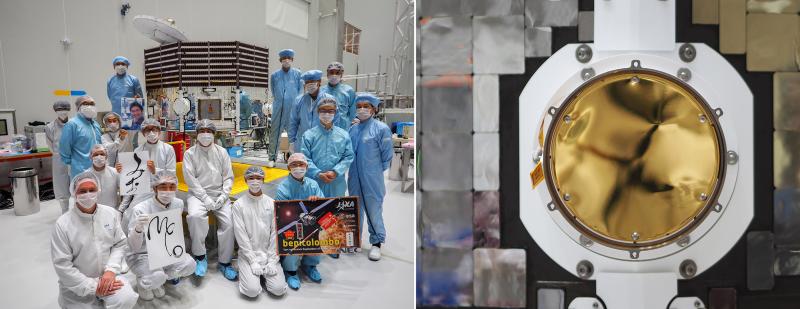BepiColombo : last instrument checkings and tests for MIO – the Mercury Magnetospheric Orbiter – before launch !
On June 21-27 the IRAP BepiColombo Team has flown to Europe’s Spaceport in Kourou in order to perform the last checkings of the two Mercury Electron Analyzers (MEA) built by IRAP for the mission.

In a joint effort with the japanese teams from JAXA and NEC the instruments were cleaned and their thermal shields mounted for the last time before launch. After the alignement of the instruments has been carefully checked for the last time, red-tag items were installed in order to protect the sensor heads from contamination and dust. These items will be removed about one week before launch. Electrical tests were performed and confirmed the good health of the instruments. The MIO spacecraft is now ready to be integrated onto the complete BepiColombo stack with the Mercury Planetary Orbiter (MPO), the Mercury Transfer Module (MTM), and the Mercury Magnetospheric Orbiter’s Sunshield and Interface Structure (MOSIF) shield.
The instrumental contributions of IRAP to the MMO / JAXA probe consists in designing, manufacturing and delivering two “electron analyzer” sensors (MEA). This is a contribution to the instrumental ensemble of charged particle measurements (MPPE ISAS-JAXA).
BepiColombo is a joint mission between ESA and the Japan Aerospace Exploration Agency (JAXA), executed under ESA leadership. The mission comprises two spacecraft: the Mercury Planetary Orbiter (MPO) and MIO, the Mercury Magnetospheric Orbiter. The joint ESA-JAXA BepiColombo mission will be launched around 01:45 GMT (03:45 CEST) on October 19 by an Ariane 5 from Europe’s Spaceport in Kourou.
Contacts IRAP
- Nicolas André (CNRS), lead scientist and technical manager of MEA, nicolas.andre@irap.omp.eu
- David Moirin (NEXEYA), PAQA engineer, david.moirin@irap.omp.eu






